
PREMIER League, OCTOBER 4 2025
Caicedo (14)
Estêvão (90+5)
Gakpo (63)
Highly rated Brazilian youngster Estêvão Willian scored a late winner for Chelsea against the champions in this game at a raucous Stamford Bridge. The result meant Liverpool slipped from top spot after seven rounds of the Premier League season. Five of their league games have involved goals in added time of the second half, but for the second week in a row it led to defeat for Arne Slot’s side. Whereas for Chelsea, who conceded twice in added time to lose to Brighton in their previous Premier League outing, it was a very welcome three points.
Moisés Caicedo gave Enzo Maresca’s Blues a first-half lead with an unstoppable shot past Liverpool’s Premier League debutant, Giorgi Mamardashvili. Just after the hour mark Cody Gakpo levelled, pouncing in the six-yard box to convert an Alexander Isak assist from a Dominik Szoboszlai cross. But Chelsea finished strongly, with Enzo Fernández heading a golden opportunity against the post in added time. Estêvão spared his blushes minutes later, with the 18-year-old converting Marc Cucurella’s cross to claim the points.
How the coaches saw it
“We believe we deserved the victory after the chances we created and how we played,” said assistant coach Willy Caballero, standing in for a red-carded Enzo Maresca in post-match interviews. “We finished with a back four of full-backs, which is unusual, and all the players did really well. The players from the bench were also ready to run and play for us; they showed a really good effort in different positions and didn’t ask questions.”
“If you play the style we play – a high press,” said Slot, “and the style Chelsea plays – a high press – it would be a surprise if both teams, with the quality that both teams have, that they never play through your press. That would be unrealistic. You go here to Stamford Bridge with them having eight injuries, so you’re like: ‘This can be positive, then they probably don’t have the options from the bench.’ But they did still have a few good options from the bench to impact the game.”
 1353424252749872025125461038118189
135342425274987202512546103811818912/6
SHOTS / ON TARGET
12/2
52%
POSSESSION
48%
36
ATTACKS INTO AREA
27
1.22
EXPECTED GOALS (XG)
1.83
Chelsea’s high central midfielders
From their 4-2-3-1 structure, Malo Gusto broke forward as often as possible, joining Fernández as a number eight. Up against Liverpool’s 4-2-3-1, both positioned themselves very high, dragging their opposite number with them. On Chelsea’s right, full-back Reece James moved inwards to give Gusto more licence to attack high. On their left, Marc Cucurella provided overlapping runs to work around Fernández (below), especially when the latter moved higher in place of Alejandro Garnacho.
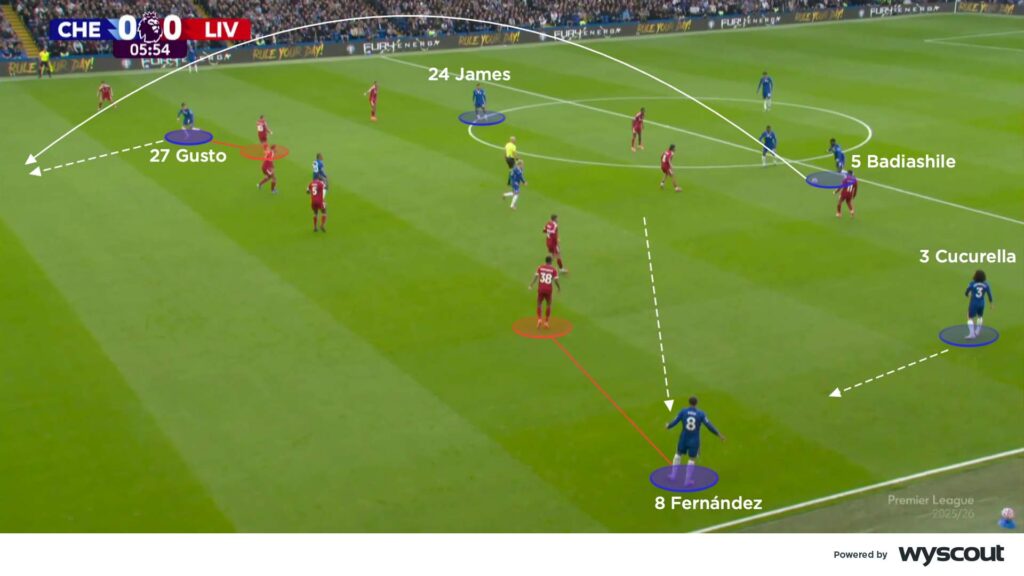
Chelsea’s use of high midfielders played a big part in their opening goal. Liverpool’s Szoboszlai looked to jump out from midfield and put pressure on the opposition’s centre-backs, leaving a free Chelsea midfielder. Starting high, both Fernández and Gusto dropped to the ball, late but fast, opening up bounce passes into a free and forward-facing Caicedo (below). When the pass from the back line was timed with these movements, Chelsea had a central base to attack from, as when Caicedo scored.
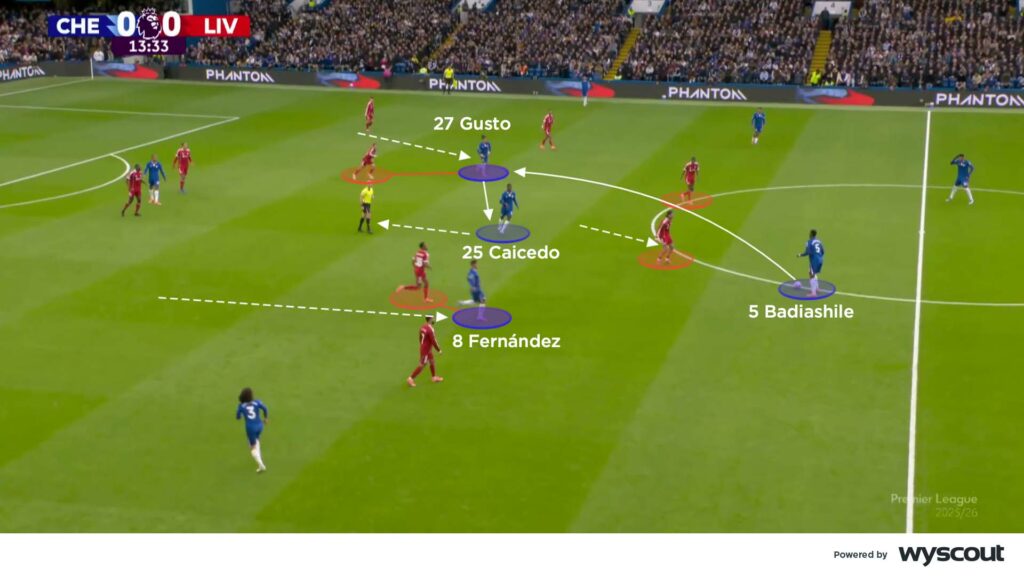
Isak dropping versus Chelsea’s left-side jump
Chelsea were then quite content without the ball for periods of the first half, but still put aggressive pressure on Liverpool when appropriate. This usually stemmed from their left side, as Garnacho jumped on to Ibrahima Konaté, with Cucurella then following on to Conor Bradley. Liverpool initially struggled to progress as their central midfield three were covered man-for-man. Chelsea’s numbers limited Liverpool’s attempts to combine, so Alexander Isak began to drop deep (below) in an attempt to overload and help work the ball across the pitch as the main target player.
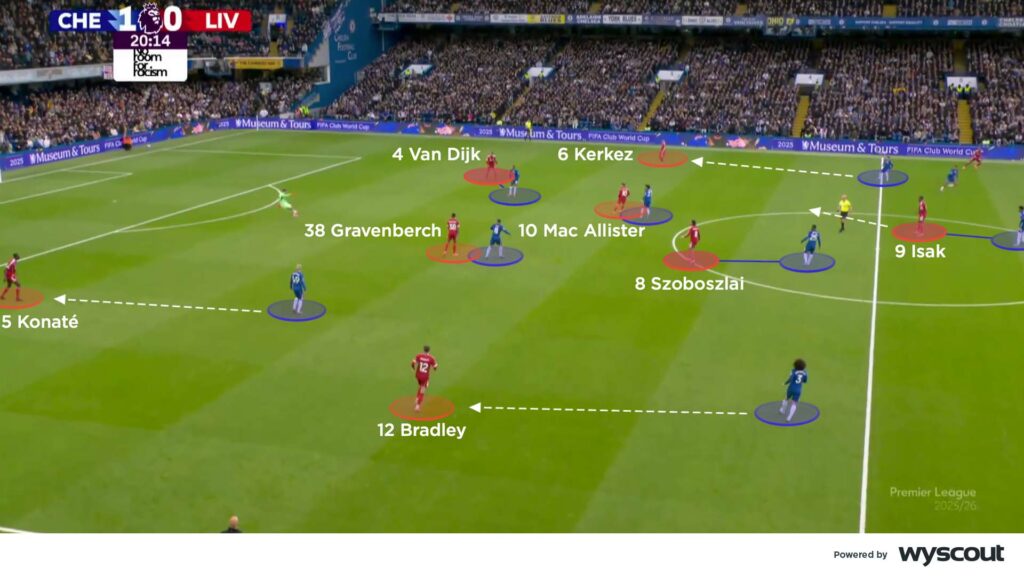
With Isak dropping short to link the back line and midfield together, Liverpool had many players underneath the ball, rarely running the other way. Chelsea’s centre-backs could tightly follow Isak – sometimes nicking the ball to start an attacking transition of their own (below). With the back four and midfield three deeper, Liverpool lacked penetration and didn’t often break through, around or over, with Chelsea’s left side still prepared to jump when needed.
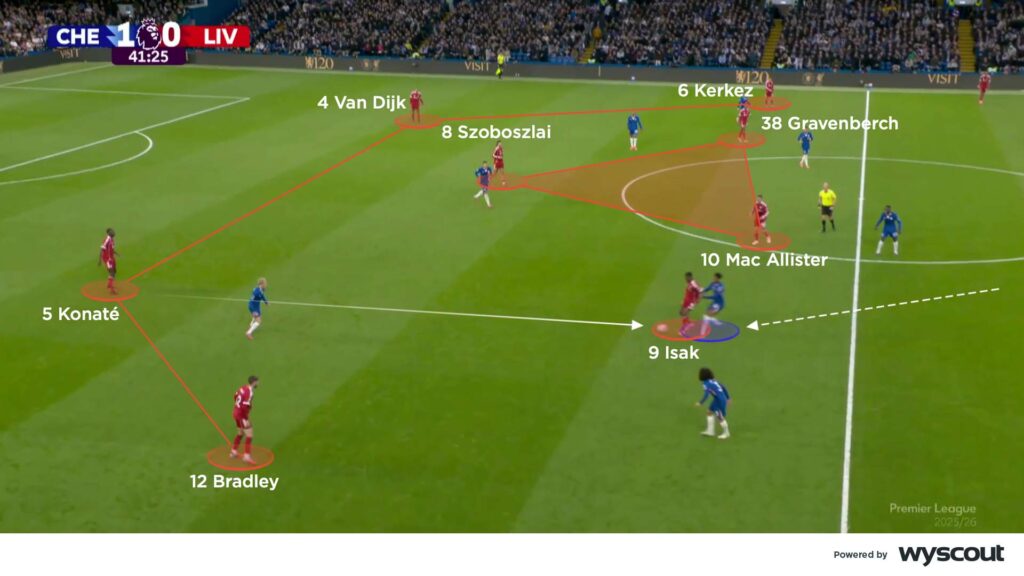
Slot added Florian Wirtz at half-time, moving Szoboszlai to right-back in place of the substituted Bradley. The substitute gave Liverpool an immediate presence moving the other way when Isak dropped. Although Chelsea continued to jump from their left side, Mohamed Salah made more purposeful runs in the second half, linking well with Wirtz when the latter broke free of Caicedo’s marking. On Liverpool’s left, Cody Gakpo also made more aggressive runs in the second half, with the visitors having a much stronger attacking presence between the lines.
Slot then moved Ryan Gravenberch to centre-back in place of Konaté, bringing on Curtis Jones in midfield. Gravenberch’s forward passing from centre-back sometimes skipped his midfield out entirely, working straight into Liverpool’s increasingly dangerous front line (below).
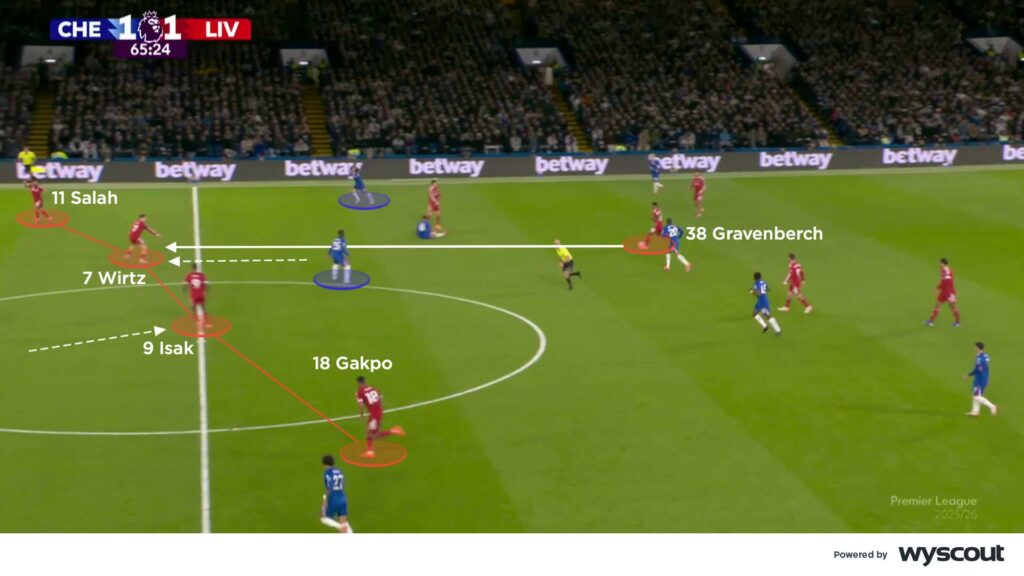
Chelsea continued to jump from their left side, with Cucurella sometimes leaving Salah free to attack the centre-backs, driving in on the angle from wide right. Gravenberch continued to outplay Garnacho’s inward press, linking with those ahead. When Wirtz was unable to connect due to Caicedo’s presence, Isak dropped as a decoy and Jones ran forward to receive and link with the front line (below). This coincided with Liverpool’s best period of the match, but they were unable to grab a second goal, despite creating strong final-third entries.
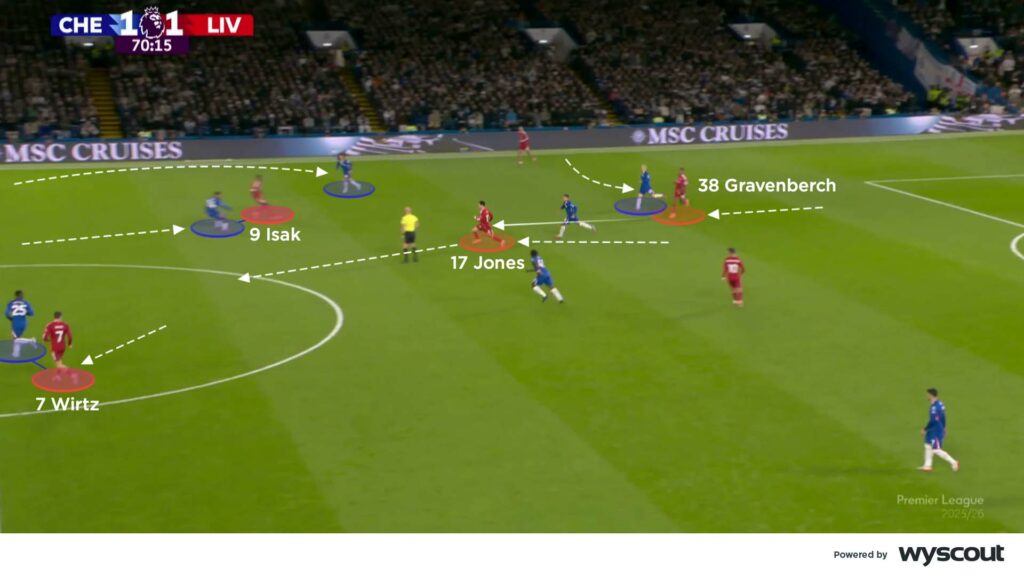
Chelsea’s left-sided outlet
Chelsea’s left side continued to jump, which meant they could attack with numbers when they regained possession in their own half. Salah rarely tracked back, meaning Chelsea could double up on Liverpool’s right back – a constant outlet to exploit in second-half transitional moments. When Liverpool’s midfield attempted to support Szoboszlai, Fernández moved high and across, turning a 2v 1 into a 3v2 for Chelsea. The final period of the match became whichever team could punish the other first. Most of the purposeful play from both teams came on the same side of the pitch.
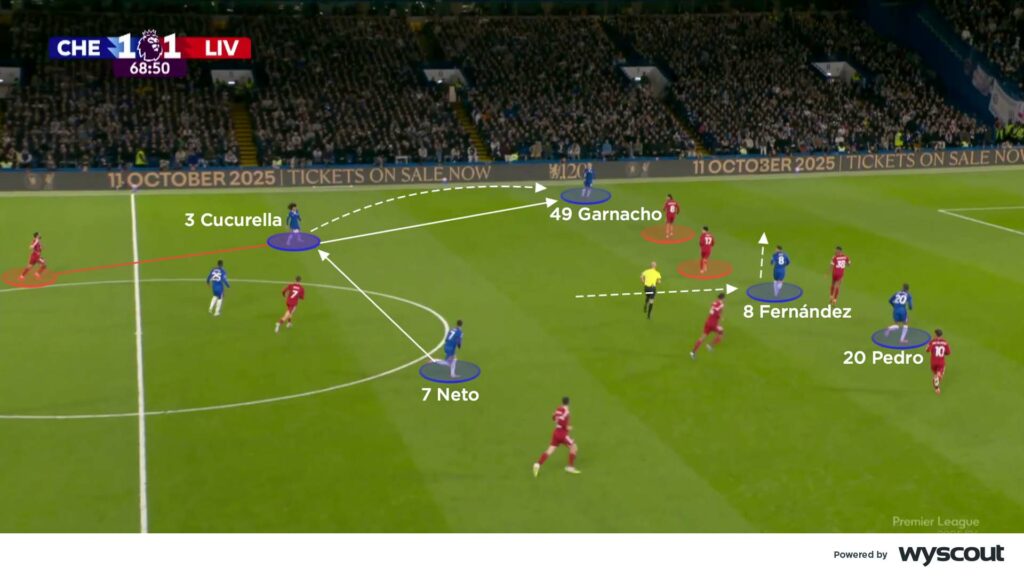
Cucurella duly delivered a cross from the left which Estêvão snuck in at the back post to finish. The game had become extremely transitional in the latter periods; this better suited Chelsea, who added fresh wingers in Jamie Gittens and Estêvão. The pair constantly got at their respective opponents, looking strong on the break and forcing Liverpool back to defend their box. On their left in particular, Chelsea had numbers and growing confidence. They drew Liverpool over, which gave Estêvão space to attack the box and grab the winner.
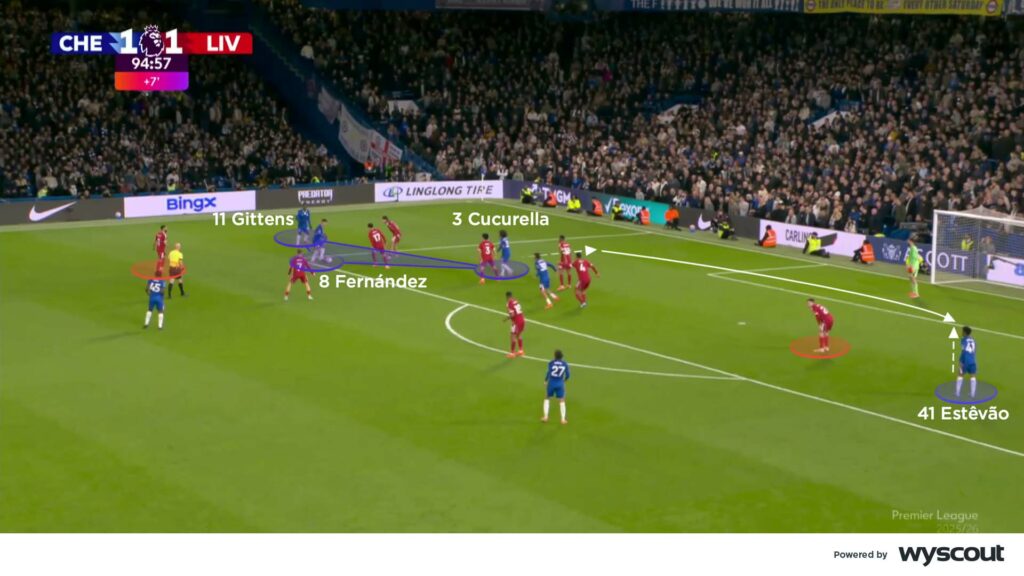
The result lifted Chelsea up to sixth for the time being, while for all their struggles, Liverpool ended the game a point off new leaders Arsenal. With the international break coming up, Slot has plenty of work to do to arrest his team’s slump. Maresca and Chelsea, by contrast, will be buoyed by this result, if disappointed they have to wait two weeks until their next game.
To learn more about football tactics and gain insights from coaches at the top of the game, visit CV Academy



